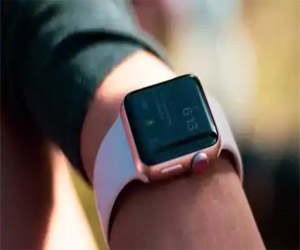- Home
- Editorial
- News
- Practice Guidelines
- Anesthesiology Guidelines
- Cancer Guidelines
- Cardiac Sciences Guidelines
- Critical Care Guidelines
- Dentistry Guidelines
- Dermatology Guidelines
- Diabetes and Endo Guidelines
- Diagnostics Guidelines
- ENT Guidelines
- Featured Practice Guidelines
- Gastroenterology Guidelines
- Geriatrics Guidelines
- Medicine Guidelines
- Nephrology Guidelines
- Neurosciences Guidelines
- Obs and Gynae Guidelines
- Ophthalmology Guidelines
- Orthopaedics Guidelines
- Paediatrics Guidelines
- Psychiatry Guidelines
- Pulmonology Guidelines
- Radiology Guidelines
- Surgery Guidelines
- Urology Guidelines
Apple Watch turns life saviour for man with atrial fibrillation

Apple watch turned out to be a life saviour for a man after a doctor in the U.S. saved the life of the patient while sitting in a restaurant. He did this by using his Apple Watch Series 4 for detecting deadly heart condition called atrial fibrillation.
Such stories of Apple Watch saving life are not new and have been reported in the past as well. Back in 2015, the tech publication SlashGear reported the Apple Watch saved a teen's life when his device warned him his heart rate had reached dangerous levels while he was in class.
Instead of ignoring the warning, he notified the school nurse, who sent him to the hospital, where doctors confirmed a diagnosis of rhabdomyolysis, a syndrome that is caused by muscle injury, where the protein myoglobin is released into the blood, causing the liver, heart, and kidneys to shut down.
Healthcare professionals have shown increasing interest in wearable devices' ability to provide critical health warnings. A recent Cleveland Clinic study looked at the Apple Watch's role in healthcare.
Atrial fibrillation, or AFib, is an irregular and rapid heart rate that increases risk of stroke, heart failure, and other complications. The condition often goes undiagnosed as it remains hidden because many people do not experience any symptoms. There is no cure for AFib, and while medications and procedures can often help, they are not always successful.
The irregular rhythm notification feature is a recent feature on the Apple Watch that can check heart rhythms and send a notification if an irregular heart rhythm that appears to be atrial fibrillation is identified.
Apple Watch Series 4 is now helping users in the US, Europe and Hong Kong take an electrocardiogram (ECG) right from their wrist, capturing heart rhythm in a moment when they experience symptoms like a rapid or skipped a heartbeat and helping to provide critical data to physicians
The key health feature on Apple Watch is yet to arrive in India.
"As a physician, it's much faster to put my #applewatch4 on someone else's wrist to detect disease (A. fib) than finding an ECG machine at a public restaurant! (Indeed, a true #mhealth guardian)," tweeted Tommy Korn, an ophthalmologist from San Diego, California.
The person diagnosed with A-fib was later doing fine, said Dr Korn in the replies to his tweet.

Disclaimer: This site is primarily intended for healthcare professionals. Any content/information on this website does not replace the advice of medical and/or health professionals and should not be construed as medical/diagnostic advice/endorsement or prescription. Use of this site is subject to our terms of use, privacy policy, advertisement policy. © 2020 Minerva Medical Treatment Pvt Ltd